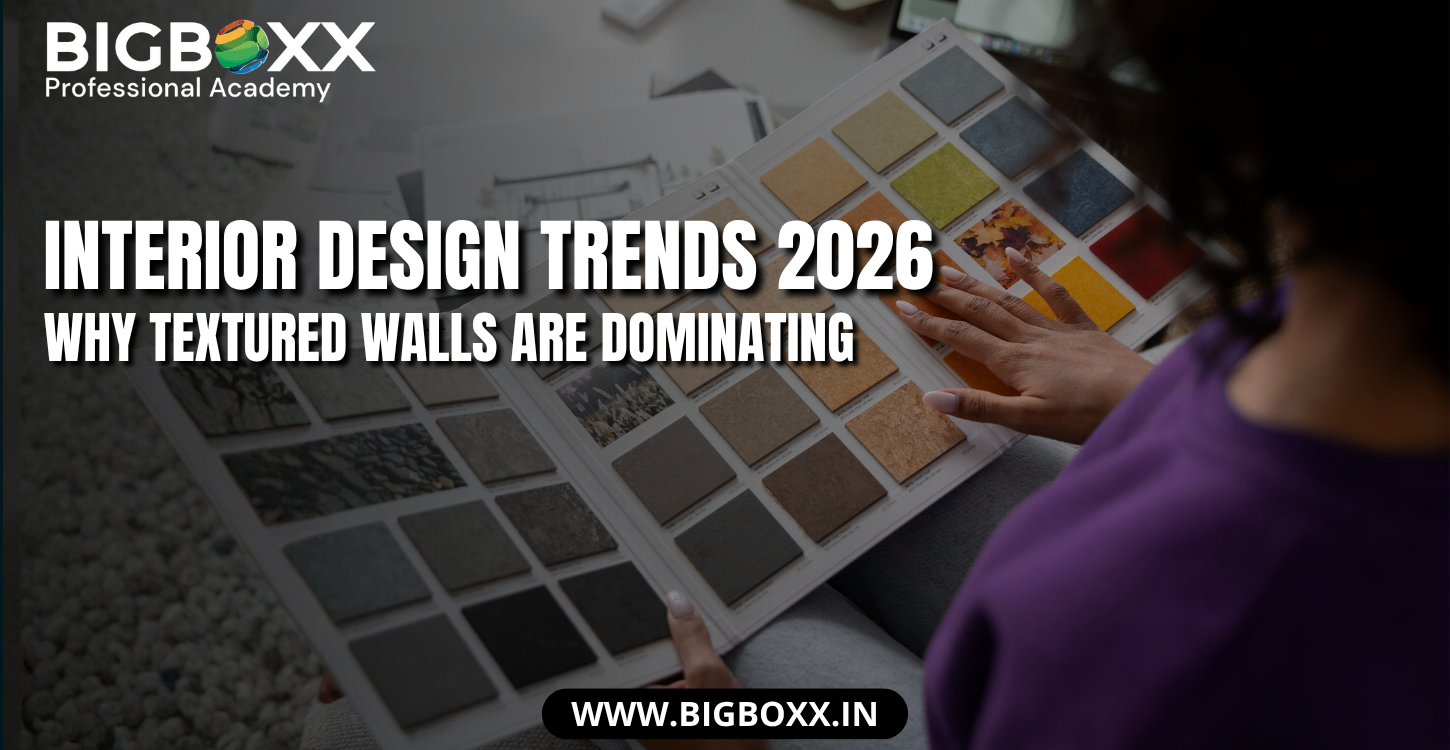Why Textured Walls Are Dominating Interior Design Trends 2026.
Introduction: The Sensory Shift in interior design trends 2026.
As we enter 2026, we stand at a significant turning point for Interior design trends 2026. Designers worldwide—residential, commercial, retail, or hospitality—have turned their attention to materiality that can be felt, experienced, embodied, and connected to, rather than just viewed.
This new focus has brought textured walls and surfaces to the forefront of design conversations. No longer primarily ornamental, designers now see texture as a leading design element that shapes the entire spatial experience.
Diploma in interior Designing Course in ChandigarhToday’s modern human spends 85% or more of their daily lives indoors, forcing designers to think differently about the flatness of painted walls and brick. Designers have taken on this challenge, creating textured walls and surface options that provide depth, rhythm, tactility, and a sense of warmth to our environments. interior designing course
The placidity of a smooth wall will be moved aside in lieu of sculpted, grooved, chiseled, fluted, layered, and organic textures that bring our spaces to life.
Texture in 2026 is not an accessory or an add-on; it is now the context under which designers create ambience and design that engenders mood, movement, and perception.
The Psychology of Texture Interior design trends 2026
Texture connects with the human brain in ways that color alone cannot. Neuroscience studies have found that tactile visual cues activate the emotional centers of the brain, the centers responsible for feelings of comfort, safety, nostalgia, and curiosity.
Texture Affects Mood
- Rough textures provide a sense of earthiness and relatedness
- Soft textures promote relaxation
- Patterns established by layers promote creative thinking
- Organic imperfections create calmness
Humans are biologically inclined to feel ease when around natural materials such as stone, clay, lime, and wood. Textured finishes, even in synthetic materials can help mimic that primal connection to Mother Nature and instill a sense of emotional comfort within the built environment.
The Comfort of Touched Interior design trends 2026
Even when one never physically touches the wall material, the sheer visual presence maintains a sense of warmth, relaxation, and immersion. This is why textured materials are being used within:
- wellness contexts
- spas
- mediation
- hospitality lounges
- residential high-end interiors
Texture makes a space’s experience, and not a container Interior design trends 2026
The Expansion of Macro-Textures in 2026
Macro-textures are large and in your face. They reach out to you, even from afar, while also existing as more of a sculptural form.
We are seeing oversized plaster patterns
Large shapes, either geometric or fluid in nature, created in broad sections with thick plaster, are impressive focal points. These walls take on the dimension of art installation.
Grooved and fluted Walls
The global rise of fluting we saw in furniture design is now finding its way into our built forms. Vertical grooves not only elongate walls, but they also establish a rhythm and can play with the light from nature.
Chiseled Stone and Carved Wood
Carved surfaces are a marriage between ornamental craft and a reflection of contemporary luxury. They speak to craftsmanship, skill, and tactility.
3D Printed Wall Textures
The advancements in 3D printing allow designers to create patterns that have never been accomplished using traditional crafts. 3D printed walls are becoming an inspiration from their:
- parametric design
- Biomimicry
- Generative Patterns
Micro-Textures: The Quiet Luxury Interior design trends 2026
Micro-textures are now making an impact, as being refined and timeless.
Venetian Plaster and Limewash
Smooth but subtly mottled finishes give the illusion of depth and luxury without screaming ‘look at me’.
Microcement
A highly anticipated wall covering for minimal interiors, traditional microcement is a seamless product that covers walls, floors, and ceilings.
Ultra-Matte and Velvet Touch
Mattified textures lessen glare and present as an upscale finish, which is generally used with warm lighting for a soft and approachable feel.
Material Innovation Leading the Interior design trends 2026
Material technology gives credibility to this texture movement.
Eco Plasters
Eco plasters consist of clay, sand, lime, marble dust, and natural pigments.
Bio-Based Materials
Bio-based materials include things like mycelium panels, hemp-lime textures, natural fiber composites, and breathable earthen mixes.
GFRC (Glass-Fiber-Reinforced Concrete)
GFRC is lightweight but highly sculptable, which means designers get to carve entire walls as sculptural pieces.
Smart Responsive Surfaces
Smart responsive surfaces are materials that subtly shift texture pattern based on humidity, light, or temperature changes.
Global Influences That are Driving the Texture Movement
Scandinavian Soft Minimalism
This minimalist aesthetic showcases neutral textures and earth-lime tones but with very little ornamentation.
Japanese Wabi-Sabi
This philosophy embraces imperfect textures like cracks and rough edges, as well as organic forms.
Middle Eastern Sculptural Relief
Ornamental flooring is being updated to soft geometric walls.
Indian Artisan Craft
Events like mud walls, clay textures, hand-cut stones, and intricate carvings are shaping global design trends.
Technology Driving the Trend
AI Material Simulation
Effectively, designers are able to use AI tools to produce hundreds of texture variations in the same amount of time.
Digital twins
Designers can give clients the experience of seeing textured surfaces in a variety of light conditions, along with different furniture plans.
CNC & Robotic Carving
CNC and robotic carving are driving the ability to make precise and high-volume textures.
Virtual Reality
Designers can present clients the ability to “walk through” the walls, and feel the depth of textures, before even building.
Case Studies: Real-World Transformations
Luxury Homes
Textured walls have emerged in:
- Entry foyers
- Master bedrooms
- Accent walls in dining rooms
- Home offices
- Wellness spaces
Commercial Spaces
Texture is employed as a branding device, corralling lobbies, corridors and meeting rooms.
Hospitality
Hotels introduce surfaces to maximize line-of-sight luxury and comfort.
Retail Stores
Research confirms that textured spaces increase customer dwell time
Business ROI: Why Texture Works
Textured walls translate into measurable returns.
High Property Value
Houses with texture are typically reported to sell at 12 -18% higher depending on location.
Durability
Textured finishes camouflage imperfections, as well as last beyond painted drywall.
Customization
Clients will somebody bespoke materiality, allowing designers to charge more.
Social Media & Visual Culture
Textured spaces quickly gain momentum on Pinterest and Instagram which, period increases visibility of property developers and architects.
Application Techniques
2026 is the year of hybrid craftsmanship.
- Tadelakt
- Cement plaster
- Lime plaster
- Hand carving
- Sandstone texturing
- Laser cutting
- 3D Print
- CNC routing
- Robotic plastering
Faux Textures
Modern polymers create textures that realistically replicate stone, concrete, and metals.
Combination Textures, surfaces and finishes
Smooth and rough
Matte + gloss
Organic + geometric
Help create dynamic, layered interiors.
Color & Texture Pairings use in interior design trends 2026
Texture is always heightened by a colour strategy.
Earth Tones
Clay, taupe, almond, mushroom, stone grey.
Light Play
Textures gain life
Unconventional Materials Designers are Employing in interior design trends 2026
Texture is experimental in 2026.
- Cork bark
- Jute rope patterns
- Bamboo carvings
- Clay plaster with straw
- Charred wood (Shou Sugi Ban)
- Recycled plastic-texture composites
Obstacles & Misunderstanding
- Textured walls require little upkeep; actually, the new coatings hold up well.
- They are not always cost prohibitive; there are micro-textures that fit your budget.
- To be effective, skilled application is essential; an unskilled application will spoil any texture.
The Future of Textured Walls after 2026
Designers are forecasting:
- “Multi-sensory” surfaces that combine touch, scent, and sound absorption.
- AI-generated artwork textures.
- Fully sculptural wall shifts that replace paint in a traditional way.
- Ultra-sustainable textures with local materials.
- Texture is not a trend; it is simply the future language of interior design.
Conclusion
In 2026, textured surfaces represent an impactful moment in international design. Texture is no longer decorative; it is experienced. It creates mood, it affects perception, and it invites architectural storytelling.
As technology quickly advances and sustainability is the only option, we are truly beginning the rise of textured walls. Texture is bringing humanity back into spaces. Human, warm, expressive, and extremely grounded in nature.
If you want to become a part of this modern global design movement and learn everything from textures to materiality, now is the best opportunity to grow your skills!
Our academy has an industry-based interior design course and a job-ready diploma in interior design that prepares you for real-life careers in residential, commercial, retail and luxury interior design projects.
You will learn:
- advanced materials
- techniques in wall texture design
- software skills (AutoCAD, SketchUp, 3ds Max, VR visualization)
- color theory, space planning & styling
- soft work + portfolio development
If you want to develop a professional career in interiors, this is your next step.
Contact us today to begin designing the future.



